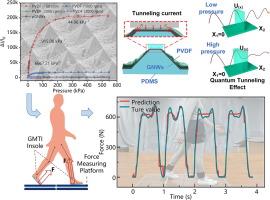用于宽范围超灵敏度压阻传感器的皮肤启发梯度微共形隧道界面
IF 13.2
1区 工程技术
Q1 ENGINEERING, CHEMICAL
引用次数: 0
摘要
柔性压力传感器已经发展到提供高灵敏度和宽范围,但在高压下保持高灵敏度仍然是一个挑战。传统的方法通常依赖于单一的策略,如改变接触面积或隧道效应,通常难以在高压下保持高灵敏度。受人体皮肤在巨大压力下打开离子通道机制的启发,本研究引入了梯度微共形隧道界面(GMTI)传感器,该传感器同时发挥了微结构变形和梯度隧道的作用。在低压(0-10 kPa)下,传感器的输出主要受接触面积变化的影响,灵敏度可达6667.21 kPa−1。随着压力的增加,传感器通过逐渐参与其梯度隧道层和扩大电子通道来模拟皮肤,从而即使在高压(10-100 kPa)下也能保持高灵敏度(915.08 kPa−1)。得益于此,GMTI传感器可以检测到重量为1300 kg的汽车下200 g的小波动,分辨率为0.15 ‰。此外,基于gmti的鞋垫已经开发出来,可以在跑步过程中测量高达2000 N的动态地面反作用力,实现高达99 %的预测精度。这种创新的方法为压力传感器提供了一种新的策略,即使在高压下也能实现高灵敏度,并增强了它们在超大动态范围内测量的适用性。本文章由计算机程序翻译,如有差异,请以英文原文为准。

Skin-inspired graded Micro-Conformal tunneling interface for piezoresistive sensors with Broad-Range Ultra-Sensitivity
Flexible pressure sensors have evolved to provide high sensitivity and broad range, yet maintaining high sensitivity at elevated pressures remains challenging. Traditional approaches, which typically rely on a single strategy such as altering the contact area or the tunneling effect, often struggle to sustain high sensitivity under high pressures. Inspired by the human skin’s mechanism of opening ion channels under significant pressure, this study introduces the Graded Micro-conformal Tunneling Interface (GMTI) sensor, in which both microstructures deformation and the gradient tunneling and are brought into play. At low pressures (0–10 kPa), the sensor’s output is predominantly influenced by contact area changes, yielding sensitivity up to 6667.21 kPa−1. As pressure increases, the sensor mimics skin by progressively engaging its gradient tunneling layers and expanding electronic channels, thus maintaining high sensitivity (915.08 kPa−1) even at elevated pressures (10–100 kPa). Benefiting from that, the GMTI sensor can detect fluctuations as small as 200 g under car weighing 1300 kg with a resolution of 0.15 ‰. Additionally, GMTI-based insoles have been developed to measure dynamic ground reaction forces up to 2000 N during running, achieving a predictive accuracy of up to 99 %. The innovative approach offers a new strategy for pressure sensors, enabling high sensitivity even under high pressure and enhancing their applicability in measurements across an ultra-large dynamic range.
求助全文
通过发布文献求助,成功后即可免费获取论文全文。
去求助
来源期刊

Chemical Engineering Journal
工程技术-工程:化工
CiteScore
21.70
自引率
9.30%
发文量
6781
审稿时长
2.4 months
期刊介绍:
The Chemical Engineering Journal is an international research journal that invites contributions of original and novel fundamental research. It aims to provide an international platform for presenting original fundamental research, interpretative reviews, and discussions on new developments in chemical engineering. The journal welcomes papers that describe novel theory and its practical application, as well as those that demonstrate the transfer of techniques from other disciplines. It also welcomes reports on carefully conducted experimental work that is soundly interpreted. The main focus of the journal is on original and rigorous research results that have broad significance. The Catalysis section within the Chemical Engineering Journal focuses specifically on Experimental and Theoretical studies in the fields of heterogeneous catalysis, molecular catalysis, and biocatalysis. These studies have industrial impact on various sectors such as chemicals, energy, materials, foods, healthcare, and environmental protection.
 求助内容:
求助内容: 应助结果提醒方式:
应助结果提醒方式:


